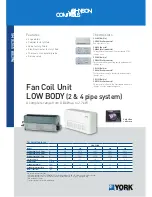
26
8. Locate and guard vent termination to prevent acci-
dental contact by people or pets.
9. DO NOT terminate vent in window well, stairwell,
alcove, courtyard or other recessed area.
10. DO NOT terminate above any door, window, or
gravity air intake. Condensate can freeze, causing
ice formations.
11. Locate or guard vent to prevent condensate from
damaging exterior finishes. Use a rust-resistant
sheet metal backing plate against brick or masonry
surfaces.
12. DO NOT extend exposed vent pipe outside of
building. Condensate could freeze and block vent
pipe.
U.S. Installations
Refer to the latest edition of the National Fuel Gas
Code.
Vent termination requirements are as follows:
1. Vent must terminate at least 4 ft below, 4 ft hor-
izontally from or 1 ft above any door, window or
gravity air inlet to the building.
2. The vent must not be less than 7 ft above grade
when located adjacent to public walkways.
3. Terminate vent at least 3 ft above any forced air
inlet located within 10 ft.
4. Vent must terminate at least 4 ft horizontally, and
in no case above or below unless 4 ft horizontal
distance is maintained, from electric meters, gas
meters, regulators, and relief equipment.
Combustion
Air Supply
Exhaust
Configuration
Heater Venting
Category
Certified
Materials
Combustion Air
Inlet Material
Vertical Natural
Draft Venting
I
“B” Vent
From Inside Building
Horizontal Through-
the-Wall Venting
III
Stainless Steel
(Gas Tight)
Vertical Natural
Draft Venting
I
“B” Vent
From Outside Building
Horizontal Through-
the-Wall Venting
III
Stainless Steel
(Gas Tight)
Galvanized Steel
PVC
ABS
CPVC
Use insulated vent pipe spacers where the vent pass-
es through combustible roofs and walls.
Vent Terminal Location
1. Condensate can freeze on the vent cap. Frozen
condensate on the vent cap can result in a blocked
flue condition.
2. Give special attention to the location of the vent
termination to avoid possibility of property dam-
age or personal injury.
3. Gases may form a white vapor plume in winter.
The plume could obstruct a window view if the ter-
mination is installed near windows.
4. Prevailing winds, in combination with below-freez-
ing temperatures, can cause freezing of conden-
sate and water/ice build-up on buildings, plants or
roofs.
5. The bottom of the vent terminal and the air intake
shall be located at least 12 in. above grade, includ-
ing normal snow line.
6. Un-insulated single-wall metal vent pipe shall not
be used outdoors in cold climates for venting gas-
fired equipment.
7. Through-the-wall vents for Category II and IV appli-
ances and non-categorized condensing applianc-
es shall not terminate over public walkways or over
an area where condensate or vapor could create
a nuisance or hazard or could be detrimental to
the operation of regulators, relief valves, or other
equipment. Where local experience indicates that
condensate is a problem with Category I and III
appliances, this provision shall also apply.
Table K: Venting Category Requirements
Summary of Contents for Raypak Delta Limited 399B
Page 39: ...39 Wiring Diagram Models 399B 1259B...
Page 40: ...40 Wiring Diagram Models 1529B 2339B...
Page 51: ...51 DIAGNOSTIC DETAIL 12 J 7 J 6 J 5 J 3 0 2 0 16 S 1 F 2 F 3 F 4 F BLOWER DETAIL...
Page 53: ...53 13 J 8 J 10 J 11 J 4 J 2 J 3 J 6 C 14 J 9 J 1 J CONTROL BOX DETAILS...
Page 57: ...57 ILLUSTRATED PARTS LIST MODELS 989B 2339B 10 J 3 O 5 O...
Page 58: ...58 12 H 6 H 7 H 8 H 2 H 9 H 3 H 5 H 1 H 4 H 1 P HEAT EXCHANGER DETAILS BURNER ASSEMBLY DETAILS...
Page 59: ...59 CONTROL BOX DETAILS 9 J 8 J 23 S 13 J 10 J 3 O 10 J 3 O 5 O FRONT SWITCH DETAILS...
Page 66: ...66...
Page 67: ...67 Raypak Inc 2151 Eastman Avenue Oxnard CA 93030 805 278 5300 Litho in U S A NOTES...
















































